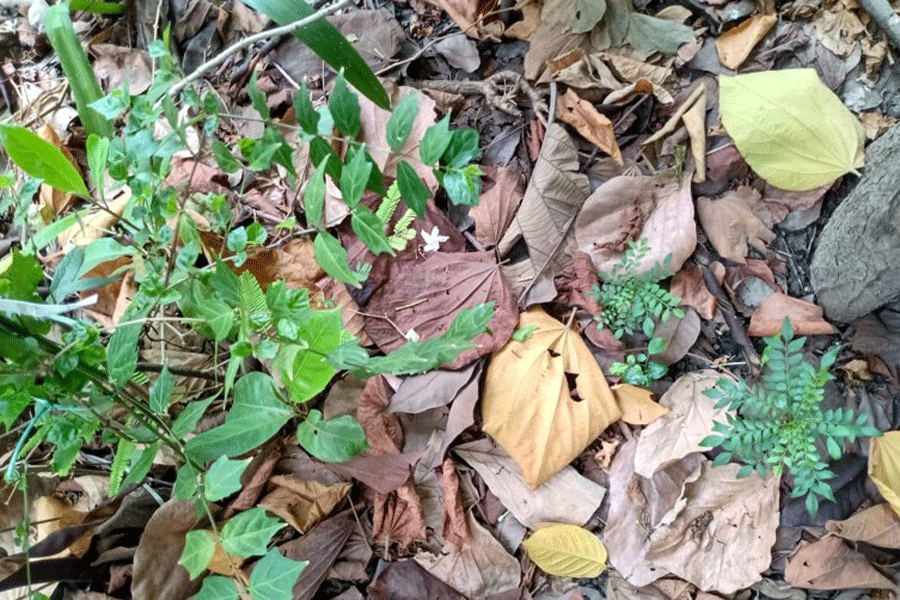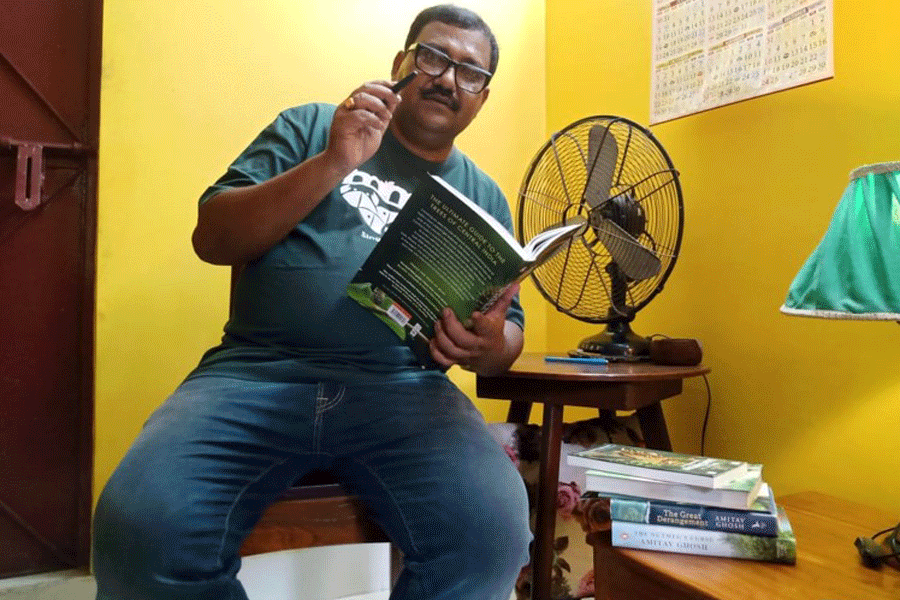Sandip Kumar Basak wants to write a book. The botanist, who is the principal of Sarat Centenary College in Hooghly, is a resident of AB 230 and wants to write it on a “tree walk in Salt Lake”. “I want to take the reader on an armchair tour of the various species growing around the township,” he says.
But the academician is busy working on environment-related projects around the state and does not know when he will have time. “The bigger question is that when I do finally get down to writing the book, will the trees of Salt Lake still be standing?” he wonders out loud.
Basak is currently working on a government-funded restoration project in the Sundarbans but it is the deteriorating state of Salt Lake’s greenery that makes him gloomy. Here’s what he shared with The Telegraph Salt Lake.

Trees in HB Block suffocate surrounded by concrete. The Telegraph
Call for tree census
I’ve been visiting the township for nature walks since 1985 and remember the wealth and variety of fauna here. Where are those trees now? The street along Kestopur Canal used to be lined by Putranjiva trees but they are gone now. The last time I saw a Cochlospermum religiosum – a tree with beautiful yellow flowers — was in 2008 in AE Block. Aakash neems are gone from BD Park, Kanak Champas are gone from BB-BC Block…
There is no logic to this system of “cut the old, plant the new”. Decadesold trees are felled for the sake of development and the compensation offered is the planting of saplings. But are these saplings nurtured into maturity? Or do they get munched by goats and trampled by shoes?
A tree takes 10-20 years to mature and till then we are deprived of oxygen. When they fell a tree, they kill an entire ecosystem of birds, squirrels, fungus and bacteria living on it.
Why complain about the heat after hacking trees? Not only does the canopy of trees provide shade, but plants intake carbon dioxide, which is a greenhouse gas contributing directly to global warming. So instead of buying more air-conditioners, simply plant more trees!

Trees in AB Block were trimmed pre-monsoon, which is not advisable. The Telegraph
We all remember multiple trees along VIP Road turning white and dying some years ago (The Telegraph Salt Lake had reported on the issue in a cover story dated June 5, 2015). We do not know what happened to them but their roots could have easily been poisoned. One is not allowed to cut live trees but for dead ones you’ll get permission.
Since the inception of the township, trees have fallen, new ones have come up but it all needs to be documented. The forest department, environment department and corporation need to collaborate and conduct a census of trees. Only then can a roadmap of future plantations be made.

Leaf litter is great for the soil. The Telegraph
Cyclone alert
Every time a cyclone topples trees, there are debates afresh about the kind of trees to be planted. Yes, trees like Krishnachura and Radhachura have soft wood and can fall easily but the real secret is “aggregate planting”.
Strong winds can topple an isolated tree but several of them together will break the wind strength. This is what the mangroves do in the Sundarbans and we need to mimic nature.
In the small patch outside my house I have planted Segun, Bokul, Folsha and Tabebuia and not one of them has fallen in Aila, Amphan or any other storm.
One can’t blame the trees alone. Many a time, the ground around the plant is concreted. It’s like a noose around the tree choking it.
Trim it right
Another problem is arbitrary and unscientific tree trimming. The Bougainvilla tree outside our own house was trimmed heartlessly a few weeks ago by the authorities. We returned home to see the branches lifeless on the ground. Nests got destroyed, birds were rendered homeless. My wife Krishna Roy, an associate professor of botany at West Bengal State University, tweeted about the incident but the authorities need to take action.
Not only is it futile trimming trees before the monsoon but also, what's wrong if canopies are allowed in bylanes? These are narrow streets where no juggernauts are expected anyway. Rather, they would provide shade to those pedestrians.
Save water plants
The authorities must leave the margins of water bodies untouched. If they concrete the portion in the name of beautification they are destroying the habitat of plants and animals thriving there.
Kestopur Canal has been concreted on the edges but nature-based solutions are needed. If the authorities are worried about soil erosion, they could use boulders on the sides instead of concrete.
Kestopur Canal also has Kochuripanas (water hyacinth) floating on it off and on. This free-floating plant traces it roots to Mexico and was introduced to India in the British era. Despite its beauty, the plant is invasive and aggressive. It spreads rapidly to cover the surface of water bodies, thereby blocking sunlight and preventing other plants from growing.
Kochuripana is a global problem and there’s no way but to manually remove them. Once uprooted, they can be used as bio-fertiliser on land. In the water, the authorities can plant the likes of Water Lilies and Shaluks, that absorb pollutants and act as natural purifiers.

Eucalyptus isn’t the best choice for Salt Lake. The Telegraph
What you can do
Grow indigenous plants. Most people these days grow flowers, Tusli and a couple of Jhau or Debdaru plants outside. That’s not enough.
If you have space, grow tall trees like Indian Almond, Haritaki, Bahera, Arjun, Chhatim and Kurchi. I’ve planted Segun, Palash, Bokul, Tabebuia, Mango, Folsha… You can also grow water plants like Alisma, Sagitaria, Lotus and free-floating plants like Azolla. Grow them in earthen pots, add some soil and change the water every fortnight to prevent mosquito larvae.
If you don’t have much space, grow whatever you can but, please, do not stop your neighbours from gardening. It is common for neighbours in Salt Lake to complain about leaf litter across the boundary wall. Some will force residents to chop off branches drooping on their side of the house too.
But leaf litter is gold. It helps the formation of new soil, retains moisture in the soil, increases fertility, maintains pH level and other parameters.
Wrong kind of trees
So much underground water has been pumped out of Salt Lake that the water table here is alarmingly low. To recharge the same we need to plant trees that will absorb rainwater and hold on to it underground. Without trees, rainwater will get evaporated from the surface of the ground before seeping into the soil.
But more damage will be done if we plant trees that are wrong for our conditions. Eucalyptus and Acacia, for instance, are popular avenue trees in Salt Lake as they grow rapidly but both are water guzzlers. The Acacia (Babla or Sonajhuri) is a desert tree and absorbs every drop of water it can. As a result, it won’t allow any other plant to grow around it.
